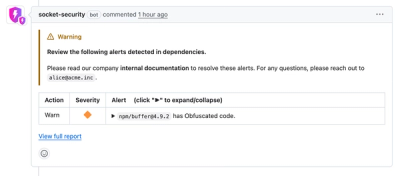
Security News
Crates.io Users Targeted by Phishing Emails
The Rust Security Response WG is warning of phishing emails from rustfoundation.dev targeting crates.io users.
ebuilder-js
Advanced tools
Highly configurable and easily manipulable elements in a single declaration, with a functionnal touch.
Build and manipulate elements the intuitive way, in a single statement with a touch a functionnal programming.
const p = EBuilder('p').setContent('Lopsum Irem').into(document.body)
npm i ebuilder-js
import EBuilder from 'ebuilder-js'
<script src="./path/to/ebuilder.min.js"></script>
EBuilder(input: string | Element | EBObject)
| Argument type | Example |
|---|---|
| string | EBuilder('p') |
| html string | EBuilder('<p>Hello <span class="italic">World</span>!</p>') |
| @rule string | EBuilder('@select:p.paragraph:nth-child(1)') |
| Element | Ebuilder(document.querySelector('p')) |
| EBObject | EBuilder(EBuilder('p')) |
target, options?)target: a Node or EBObjectoptions: { at?, times? }
at: the position in the parent. Accepts a number (0 is first, -1 is last, floats are rounded), or 'start' or 'middle' or 'end'. Default value: -1times: number of copies. Default value: 1Example:
const list = EBuilder('ul')
.setChildren([ '<li>First</li>', '<li>Last</li>' ])
.into(document.body)
EBuilder('<li>HERE WE ARE</li>').into(list, { at: 'middle', times: 3 })
/*
- First
- HERE WE ARE
- HERE WE ARE
- HERE WE ARE
- Last
*/
target)Places the element right before the target
target)Places the element right after the target
target)Places the element at the target's position and removes the target
target, animate?)If both the element and the target are in the DOM, makes them swap.
If animate is true, shows the animation.
Removes the element from the DOM
Signature:
EBuilder(x).set({}: {
attributes?: { [attributeName: string]: string },
properties?: { [propertyName: string]: any },
style?: { [styleName: string]: string },
listeners?: EventTuple | EventTuple[],
children?: EBChild | EBChild[],
})
EventTuple: array of addEventListener arguments, e.g.:[ 'click', () => console.log('clicked'), false ]
EBChild: any valid EBuilder children input (html string, Node, EBObject):children: [
'<h3>My article</h3>',
document.querySelector('p'),
EBuilder('button').setContent('read more')
]
Note that any value can be replaced with a function returning that value, see Function as value
object)object)array)EBChild | EBChild[])string | array)object)string | EBObject)Returns the current element's outerHTML, allowing a convenient access to that value:
const button = EBuilder('button').set({ ... })
someElement.innerHTML += button
string)Emits an event from the current element with the input string as a name. See event-name example for a practical use.
ReferencePair | ReferencePair[])ReferencePair: [ anyReference, 'unique-string-id' ]
Registers any reference in the EBuilder object, allowing to be accessed with an @at-rule followed by unique-string-id.
Note that if the anyReference is a named function, the string id can be omitted and the function name will be used as an id in this cas
See event-emitter example or @if example for a practical uses.
el or element: the generated HTML element.htmlContent: element's innerHTMLcount: number of childrenchildren: node list of childrenAny value can be replaced with a function to be executed in the process (provided that function returns an appropriate value). This can be useful in many situations:
this or bound argument// value is fixed
EBuilder('p').setProperties({ 'textContent@interval:500': Math.random() })
// value is dynamic
EBuilder('p').setProperties({ 'textContent@interval:500': () => Math.random() })
Function expressions are bound to the current EBuilder object through this argument, so you can get its reference within the same statement:
EBuilder('<ul><li>0</li></ul>').setProperties({
'innerHTML@on:click': function() { return this.htmlContent + `<li>${this.count}</li>` }
})
// also available as the first parameter:
EBuilder('<ul><li>0</li></ul>').setProperties({
'innerHTML@on:click': (self) => self.htmlContent + `<li>${self.count}</li>`
})
Added at the end of a key string, @-rules allow conditionnal evaluation of the corresponding value in an object. Such rules are available in every object argument of a setting method (.setStyles(), .setChildren()...), including the set() method at both levels:
EBuilder('button').set({
'properties@on:mouseover': {
'textContent@interval:1000': () => new Date().getSeconds()
}
}).into(document.body)
The corresponding value will be set when an :eventName event is emitted by the current element.
{ 'key@on:eventName': 'value' } would basically translate to
this.addEventListener('eventName', () => element.key = 'value')
This allows to do funny things quite straight-forwardly:
EBuilder('<button>click me</button>').setProperties({
'textContent@on:click': () => Math.random() < .5 ? 'win!' : 'loose!',
'innerHTML@on:mouseleave': 'Hey <strong>come back</strong>!'
}).into(document.body)
With @on the value will be updated each time the event occurs, but only the first time with @once
The event name can be any string value:
click, keydown...EBuilderinsert, EBuilderset'faisons comme ça!'Note that EBuilder allows to dispatch such events easily with the dispatch() method, which allows to do such things:
EBuilder('ul')
.setProperties({ 'innerHTML@once:hi-there': (self) => self.htmlContent + '<li>2</li>' })
.setChildren('<li>1</li>')
.dispatch('hi-there')
/*
- 1
- 2
*/
By default, the listener is set on the current element. But what if I want my element to react to an external event, like a click on a button?
To achieve this you can designate a specific target using # in the string key after the event name. But there's a catch: for EBuilder to recover the right object from that string, it must have been previously referenced with the given() method, as in the example below:
const myButton = EBuilder('button').into(document.body)
EBuilder('p')
.given([myButton, 'buttonRef'])
.setProperties({ 'textContent@once:click#buttonRef': 'Hello!' })
.into(document.body)
(More details about given() above)
The window object is an exception to this rule, as it doesn't need to be pre-indexed.
'key@timeout:duration', 'key@interval:duration'
These methods have the same behaviour as the eponym functions. Example:
EBuilder('div').into(document.body).setStyles({
width: '200px',
height: '200px',
transition: 'background 1s',
'background@interval:1000': () => `hsl(${360 * Math.random()}, 50%, 50%)`
})
Note: the interval function is referenced as the .interval property, which means you can clear it using clearInterval(myEBuilderObject.interval).
'key@if:functionReference: 'value'
The corresponding value is assigned if the specified :functionReference function returns true.
See given() method for more details about references.
const isLucky = () => Math.random() < .5
EBuilder('<button>click me</button>')
.given(isLucky)
.set({
'properties@on:click': { 'textContent@if:isLucky': 'Bravo!' }
})
-- NOT YET AVAILABLE --
'key@for:arrayReference: 'value'
FAQs
Highly configurable and easily manipulable elements in a single declaration, with a functionnal touch.
We found that ebuilder-js demonstrated a not healthy version release cadence and project activity because the last version was released a year ago. It has 1 open source maintainer collaborating on the project.
Did you know?

Socket for GitHub automatically highlights issues in each pull request and monitors the health of all your open source dependencies. Discover the contents of your packages and block harmful activity before you install or update your dependencies.

Security News
The Rust Security Response WG is warning of phishing emails from rustfoundation.dev targeting crates.io users.

Product
Socket now lets you customize pull request alert headers, helping security teams share clear guidance right in PRs to speed reviews and reduce back-and-forth.

Product
Socket's Rust support is moving to Beta: all users can scan Cargo projects and generate SBOMs, including Cargo.toml-only crates, with Rust-aware supply chain checks.